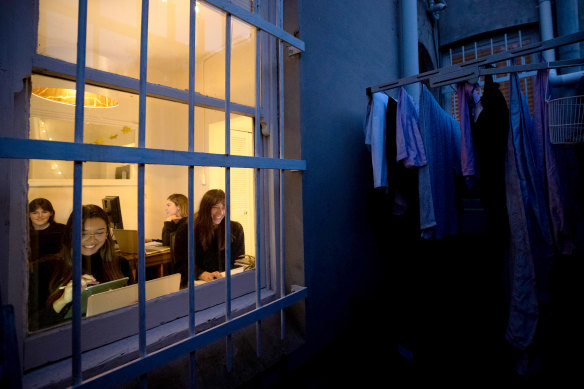- Exclusive
- National
- NSW
- Coronavirus pandemic
This was published 3 years ago
More cases, young people make up half of the infected: Why this outbreak is different
By Mary Ward and Natassia Chrysanthos
NSW has already recorded more COVID-19 cases in its latest outbreak than it did across the two months of the Avalon and Berala clusters, and this time it is affecting young people at a much higher rate.
A Herald analysis of the first three weeks of the Bondi cluster against those in the Crossroads and Avalon and Berala outbreaks revealed children and people in their 20s and 30s made up more than half of recent infections.

Georgia Rousselot, 25, with her three housemates as they work from home in a Redfern sharehouse.Credit: Janie Barrett
Chief Health Officer Kerry Chant has repeatedly called on young people to be aware of the health implications of catching COVID-19, after a person in their 20s and another in their 30s were among the 10 patients admitted to ICU this week.
On Friday, Dr Chant announced that person in their 20s was on a ventilator, as she warned the situation should be a “wake-up call” to young people and Premier Gladys Berejiklian tightened restrictions across the city.
“COVID, including the Delta strain, is not a mild disease,” Dr Chant said earlier this week.
Roughly a quarter of hospitalisations in this outbreak have been in people aged 35 and under. Among the 395 local cases recorded between June 15 and July 7, 156 were in people aged 20 to 39 – nearly 40 per cent of all cases.
During the three months of the Crossroads cluster, which began in July last year, there were 171 cases in their 20s and 30s (30 per cent of all cases). The age group made up just 25 per cent of cases during the Avalon and Berala clusters over summer.
But there is a sense of frustration among young people who are bearing the brunt of lockdown restrictions – and now case numbers – while being at the bottom of the queue to get vaccinated.
Georgia Rousselot, 25, lives with three other women in an inner-city share house with one bathroom. All four have had to work side-by-side from the dining room. When one housemate was designated a close contact last month, proper isolation felt impossible.
They’ve been holding themed dinner nights to boost their moods and fight off feelings of claustrophobia.
“But it’s been hard having to put life goals on hold and feel like it’s another year lost because of COVID and no hope of it ending, particularly when you are unsure if you can see your family or not,” Ms Rousselot said.
“Seeing the hospitalisation rates rise and young people being included in the statistics is pretty terrifying. Especially when we aren’t able to get vaccinations at this time.”
Another big difference between this outbreak and previous periods of transmission was seen in those who have not got the virus.
Fifty-two of the 395 cases recorded in the first three weeks of the Bondi cluster were aged 60 and over – just 13 per cent of all cases.
In contrast, people in this age group made up 50 of the cases in the Avalon and Berala clusters (23 per cent) and 101 cases in the Crossroads cluster (18 per cent).
Currently, people aged 40 and under are not eligible for a COVID-19 vaccine in NSW unless they have a qualifying health condition or other circumstance, or a GP determines they can receive the AstraZeneca vaccine. Two-thirds of people aged 70 and over in the state have received their first dose of a vaccine.
Australian National University infectious diseases physician Associate Professor Sanjaya Senanayake said vaccination had “certainly had an impact” on concentrating the spread of COVID-19 in Sydney in people aged under 40.
He noted that, although staff had brought COVID-19 into a north-west Sydney aged care home, the illness reported in vaccinated residents had been mild and their hospitalisation was precautionary.
“But the reality is even young people can still get very sick from the acute illness, and then there is also long COVID to contend with,” he said.
The number of people in their 40s and 50s with the virus also declined, although only slightly. There were 52 cases in the first three weeks of the Bondi cluster (26 per cent of all cases), compared with 101 during Crossroads (29 per cent) and Avalon and Berala (28 per cent).
Twenty-one per cent of recent cases were in children and teenagers, roughly the same proportion as was recorded during the Crossroads cluster, when dozens of schools shut for deep cleaning after students attended school grounds while infectious, and Avalon and Berala clusters.
Stay across the most crucial developments related to the pandemic with the Coronavirus Update. Sign up to receive the weekly newsletter.